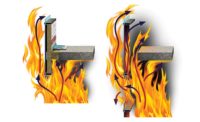
Expert Drywall of Redmond, Wash., is one of this year’s Northwest Wall & Ceiling Bureau’s award winners for its work on the Bill and Melinda Gates Foundation (the charitable organization founded by the creator of the Microsoft Corporation) Iris Campus in Seattle. The campus is more than a half-million square feet of sustainable green architecture and a dramatic inclusion to an already storied city skyline.
The new Iris Campus of the Bill and Melinda Gates Foundation is actually two buildings, twin “boomerang” shapes turned inward towards each other. The exterior of the buildings is made up of several different materials: metal panels, glass curtain wall, stone and stucco. The mixture of so many different construction materials called on project managers to come up with new ways of addressing the job.

Out of Many, One
“There are double-framed exterior chase walls that had to align with stone and various other exterior finishes,” Expert Drywall On-Site Project Manager Mark Leavitt says. “There was copper cladding on the exterior soffit and some of those were 80 feet in the air. We had to do a significant amount of welding to support the heavy stone paneling and copper cladding systems. The enormity of the project, the difficulty in gaining access mandated by the building design and the details were all things we had to attempt to capture.“The design also called for the cowled walls to replicate the curtainwalls” Leavitt says. “The building has stack joints which were constructed to allow the building to drift.”
In the event of an earthquake, one floor shifts to the right and the floors above and below are likely to shift to the left and vice-versa. Everything the stack joints in the curtain walls were called on to do, the framing had to be able to do the same.
“It’s uncommon for metal stud framing to be constructed in this manner,” Leavitt says. “There is a lot of heavy stone paneling over the framing and we had to maintain the moving stack joints. We had to coordinate our work with the stone cladding and account for the various different kinds of sheathing we were using. It made the job significantly more complex.”

Curb Appeal
Leavitt says Expert Drywall hired structural engineering consultants Anderson-Peyton to provide light gauge framing engineering and details to work with the architects’ design. A detail Leavitt called the “peel wall,” a section of wall that protrudes from the outer, convex angles of the building, were a challenge.“We had to have a special track made as these exterior wall segments were tapered and also incorporated stack joints,” he said. “It went from 4- to 8-inches thick framed and sheathed and provided a unique aesthetic feature.”
The new campus buildings are comprised of more than 600 reinforced gypsum column covers-a prodigious amount for any building. Expert Drywall President Jim McDade says that was a significant number, considering that most of the jobs the company has done in the past seldom utilize any GRG column covers as architectural finishes.
“It turned out to be a valuable learning experience for the company,” McDade says.
The learning experience, in this case, was logistical. McDade says he and his team needed to come up with a way to get that many column covers installed in a single go. The people at Expert Drywall came up with a game plan to get the job done.
“We developed a good process for getting the columns installed and finished now,” he says. “In the atrium areas, there are four towering column covers, 55 feet tall (four stories) that terminated into the underside of the suspended finished wood ceiling. Installation of the columns was made extremely difficult as the columns had to be installed through a massive scaffold system being used by all trades in the atrium area.”
A part of the job McDade particularly liked, the buildings’ commissary area, which had an elliptical drywall ceiling with many different radius/elliptical shaped reveals throughout. “It’s a unique feature,” he says. “It was very labor intensive, it took a lot of work, but the results were exceptional and award winning.”
Overall, the entire project was extremely challenging for Expert Drywall, but both McDade and Leavitt say the company was very fortunate to be a part of this landmark project.

Big Green
According to the Gates Foundation, “The project started seven years ago with the initial target of LEED Silver, in support of the City of Seattle’s green building mandate,” says Principal and Lead Sustainable Designer at NBBJ Margaret Montgomery. “Our main goal was to design the right building for the foundation staff and surrounding community. It just so happened that the best solutions were also the greenest.”Water conservation was a big goal for the project to protect the local watershed from further depletion and pollution. A 1 million-gallon rainwater storage tank underneath the campus is responsible for the majority of the water conservation. The two-acres of living roofs absorb a significant amount of the rainwater runoff and the remaining roof and hardscape runoff is collected in the rainwater storage tank, cleaned of pollutants and filtered back into the campus for reflecting pools, irrigation and toilets. These systems, plus efficient plumbing fixtures reduced the campus’ potable water use by nearly 80 percent and eliminated all polluted rainwater runoff.
The campus also includes a variety of energy efficient strategies, such as a roof-mounted solar energy system which provides energy for more than a third of the hot water use. Below the surface is a 750-thousand gallon water storage system that minimizes energy used to cool buildings by chilling stored water at night for recirculation during the day. The overall energy use has been reduced by nearly 40 percent and the upfront investment the foundation made in a 100-year, energy-efficient building will pay for itself in less than 30 years.
The new Bill & Melinda Gates Foundation campus has been awarded LEED-NC (Leadership in Energy and Environmental Design for New Construction) Platinum certification from the United States Green Building Council-making it the largest, non-profit LEED-NC Platinum building in the world, according to the Gates Foundation website. Finished just this spring, the Gates campus buildings share a neighborhood with the internationally-recognizable Seattle Space Needle.

More?
Dealing with many different products and materials, combined with the uniquely shaped buildings made the the work at the Iris Campus very labor-intensive. McDade says Expert Drywall worked on the exterior of the building for about a year and were about 20 months on the job site altogether.Leavitt calls the work the company did on the Gates Foundation site a “once in a lifetime project” but that they’re hoping to have a second opportunity as plans for a next phase at the Iris Campus are being drawn up.
The Gates Foundation’s mandate is global and its pockets are (famously) deep. According to Melinda Gates, “the campus will be a hub for advocates and experts from all over the world who are driving innovation to help find solutions to global issues.”
McDade says the Foundation plans to put up another building on the Iris Campus. Plans for that third building are in the design phase now and construction will depend on the foundation’s growth and space needs.
Industry Players:
Manufacturers:Armstrong World Ind.
Award Metals
BMI Products of Northern California
ClarkWestern Building Systems (now ClarkDietrich)
Fry Reglet Architectural Metals
GC Products
Georgia-Pacific
Grabber Construction Products
Hilti
Parex USA
SCAFCO Steel Stud Mfg
USG
Suppliers:
Commencement Bay Construction Products
Gypsum Wallboard Supply



Report Abusive Comment